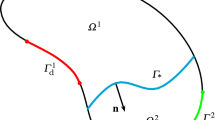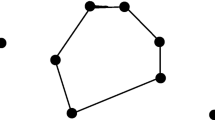Abstract
A novel technique to formulate arbritrary faceted polyhedral elements in three-dimensions is presented. The formulation is applicable for arbitrary faceted polyhedra, provided that a scaling requirement is satisfied and the polyhedron facets are planar. A triangulation process can be applied to non-planar facets to generate an admissible geometry. The formulation adopts two separate scaled boundary coordinate systems with respect to: (i) a scaling centre located within a polyhedron and; (ii) a scaling centre on a polyhedron’s facets. The polyhedron geometry is scaled with respect to both the scaling centres. Polygonal shape functions are derived using the scaled boundary finite element method on the polyhedron facets. The stiffness matrix of a polyhedron is obtained semi-analytically. Numerical integration is required only for the line elements that discretise the polyhedron boundaries. The new formulation passes the patch test. Application of the new formulation in computational solid mechanics is demonstrated using a few numerical benchmarks.




















Similar content being viewed by others
References
Aldakheel F, Hudobivnik B, Wriggers P (2019a) A low order 3D virtual element formulation for finite elasto-plastic deformations. Comput Mech 63:253–269
Aldakheel F, Hudobivnik B, Wriggers P (2019b) Virtual elements for the finite thermo-plasticity problems. Comput Mech 64:1347–1360
Atluri SN, Zhu T (1998) A new Meshless Local Petrov–Galerkin (MLPG) approach in computational mechanics. Comput Mech 22(2):117–127
Babûska I, Banerjee U, Osborn JE (2003) Survey of meshless and generalized finite element methods: a unified approach. Acta Numer 12:1–125
Belytschko T, Gu YY, Gu L (1994) Element-free Galerkin methods. Int J Numer Methods Eng 37(2):229–256
Belytschko T, Lu YY, Gu L (1995) Crack propagation by element-free Galerkin methods. Eng Fract Mech 51(2):295–315
Bishop JE (2014) A displacement-based finite element formulation for general polyhedra using harmonic shape functions. Int J Numer Methods Eng 97:1–31
Bower AF (2009) Appl Mech Solids. CRC Press, Boca Raton
Brezzi F, Lipnikov K, Simoncini V (2005) A family of mimetic finite difference methods on polygonal and polyhedral meshes. Math Models Methods Appl Sci 15(10):1533–1551
Brezzi F, Lipnikov K, Shashkov M, Simoncini V (2007) A new discretization methodology for diffusion problems on generalized polyhedral meshes. Comput Methods Appl Mech Eng 196:3682–3692
Cangiani A, Dong Z, Georgoulis EH, Houston P (2017) hp-version discontinuous galerkin methods on polygonal and polyhedral meshes. Springer, Cham
Cardiff P, Tuković Ž, Jasak H, Ivanković A (2016) A block-coupled Finite Volume methodmethod for linear elasticity and unstructured meshes. Comput Struct 175:100–122
Chen JS, Wu CT, Yoon S, You Y (2001) A stabilized conforming nodal integration for Galerkin mesh-free methods. Int J Numer Methods Eng 50:435–466
Chi H, ao da Veiga LB, Paulino GH (2017) Some basic formulations of the virtual element method (VEM) for finite deformations. Comput Methods Appl Mech Eng 318:148–192
da Veiga LB, Brezzi F, Cangiani A, Manzini G, Marini LD, Russo A (2013) Basic principles of virtual element methods. Math Models Methods Appl Sci 23(1):199–214
da Veiga LB, Dassi F, Russo A (2017) High-order virtual element method on polyhedral meshes. Comput Math Appl 74:1110–1122
Dimitrov A, Andra H, Schnack E (2001) Efficient computation of order and mode of corner singularities in 3D-elasticity. Int J Numer Methods Eng 52:805–827
Dvorak P (2006) New element lops time off CFD simulations. Mach Des 78:154–155
Floater M (2003) Mean value coordinates. Comput Aided Geom Des 20:19–27
Francis A, Ortiz-Bernardin A, Bordas SPA, Natarajan S (2017) Linear smoothed polygonal and polyhedral finite elements. Int J Numer Methods Eng 109:1263–1288
Gain AL, Talischi C, Paulino GH (2014) On the virtual element method for three-dimensional linear elasticity problems on arbitrary polyhedral meshes. Comput Methods Appl Mech Eng 282:132–160
Ghosh S, Moorthy S (2004) Three dimensional Voronoi cell finite element model for microstructures with ellipsoidal heterogeneities. Comput Mech 34:510–531
Gingold RA, Monaghan JJ (1977) Smoothed particle hydrodynamics—theory and application to non-spherical stars. Mon Not R Astron Soc 181:375–389
Goswami S, Becker W (2012) Computation of 3-D stress singularities for multiple ccrack and crack intersections by the scaled boundary finite element method. Comput Mech 175:13–25
Hillman M, Chen JS (2016) An accelerated, convergent, and stable nodal integration in Galerkin meshfree methods for linear and nonlinear mechanics. Int J Numer Methods Eng 107(7):603–630
Huang Y, Yang Z, Ren W, Liu G, Zhang C (2015) 3D meso-scale fracture modelling and validation of concrete based on in-situ X-ray computed tomography images using damage plasticity model. Int J Solids Struct 67–68:340–352
Joshi P, Meyer M, Rose T. De, Green B, Sanocki T (2007) Harmonic coordinates for character articulation. ACM Trans Graph 26(3), 71
Kraus M, Steinmann P (2012) Finite element fformulation for 3D convex polyhedra in nonlinear continuum mechanics. Comput Assist Methods Eng Sci 19:121–134
Lee C, Kim H, Im S (2016) Polyhedral elements by means of node/edge-based smoothed finite element method. Int J Numer Methods Eng 110:1069–1100. https://doi.org/10.1002/nme.5449
Liszka TJ, Duarte CAM, Tworzydlo WW (1996) hp-Meshless cloud method. Comput Methods Appl Mech Eng 139:263–288
Liu GR, Gu YT (2001) A point interpolation method for two-dimensional solids. Int J Numer Methods Eng 50:937–951
Liu GR, Nguyen TT, Dai KY, Lam KY (2007) Theoretical aspects of the smoothed finite element method (SFEM). Int J Numer Methods Eng 71:902–930
Liu WK, Jun S, Zhang YF (1995) Reproducing kernel particle methods. Int J Numer Methods Fluids 20(8–9):1081–1106
Liu Y, Saputra AA, Wang J, Tin-Loi F, Song C (2017) Automatic polyhedral mesh generation and scaled boundary finite element analysis of STL model. Comput Methods Appl Mech Eng 313:106–132
Lucy LB (1977) A numerical approach to the testing of the fission hypothesis. Astron J 82(12):1013–1024
Meyer M, Lee H, Barr A, Desbrun M (2002) Generalized barycentric coordinates on irregular polygons. J Graph Tools 7:13–22
Natarajan S, Bordas SPA, Ooi ET (2015) Virtual and smoothed finite elements: a connection and its application to polygonal/polyhedral finite element methods. Int J Numer Methods Eng 104:1173–1199
Natarajan S, Ooi ET, Saputra A, Song C (2017) A scaled boundary finite element formulation over arbitrary faceted star convex polyhedra. Eng Anal Bound Elem 80:218–229
Oliveira T, Portela A (2016) Weak-form collocation—a local meshless method in linear elasticity. Eng Anal Bound Elem 73:144–160
Ooi ET, Song C, Tin-Loi F, Yang ZJ (2012) Polygon scaled boundary finite elements for crack propagation modelling. Int J Numer Methods Eng 91(3):319–342
Ooi ET, Song C, Natarajan S (2018) A scaled boundary finite element method for poroelasticity. Int J Numer Methods Eng 114:905–929
Perumal L, Fadel MI (2014) New polyhedral elements based on virtual node method for solid mechanics and heat transfer applications. Appl Mech Mater 493:367–371
Rajendran S, Ooi ET, Yeo JH (2007) Mesh-distortion immunity assessment of QUAD8 elements by strong-form patch tests. Commun Numer Methods Eng 23:157–168
Rashid MM, Selimotic M (2006) A three-dimensional finite element method with arbitrary polyhedral elements. Int J Numer Methods Eng 67:226–252
Rjasanow S, Weiber S (2014) FEM with Trefftz trial functions on polyhedral elements. J Comput Appl Math 263:202–217
Rodrigues EA, Manzoli OL Jr, Bitencourt LAG, Bittencourt TN (2016) 2D mesoscale concrete model for concrete based on the use of interface element with high aspect ratio. Int J Solids Struct 94–95:112–124
Saputra A, Talebi H, Tran D, Birk C, Song C (2017) Automatic image-based stress analysis by the scaled boundary finite element method. Int J Numer Methods Eng 109(5):697–738
Song C (2004) A matrix function solution for the scaled boundary finite-element equation in statics. Comput Methods Appl Mech Eng 193(23–26):2325–2356
Song C, Wolf JP (1997) The scaled boundary finite element method—alias consistent infinitesimal finite element cell method for elastodynamics. Comput Methods Appl Mech Eng 147:329–355
Song C, Wolf JP (1999) Body loads in scaled boundary finite-element method. Comput Methods Appl Mech Eng 180(1–2):117–135
Sukumar N, Tabarraei A (2004) Conforming polygonal finite elements. Int J Numer Methods Eng 61(12):2045–2066
Talebi H, Saputra A, Song C (2016) Stress analysis of 3D complex geometries using the scaled boundary polyhedral finite elements. Comput Mech 58(4):697–715
Wachspress E (1975) A rational finite element basis. Academic Press, New York
Wang XF, Yang ZJ, Yates JR, Jivkov AP, Zhang C (2015) Monte carlo simulations of mesoscale fracture modelling of concrete with random aggregates and pores. Constr Build Mater 75:35–45
Wicke M, Botsch M, Gross M, Zurich ETH (2007) A finite element method on convex polyhedra. EuroGraphics 6(3):355–364
Wolf JP, Song C (2000) The scaled boundary finite-element method: a primer—derivations. Comput Struct 78(1–3):191–210
Wu CKC, Plesha ME (2002) Essential boundary condition enforcement in meshless methods: boundary flux collocation method. Int J Numer Methods Eng 53:499–514
Zou D, Chen K, Kong X, Liu J (2017) An enhanced octree polyhedral scaled boundary finite element method and its aapplication in structure analysis. Eng Anal Bound Elem 84:87–107
Author information
Authors and Affiliations
Corresponding author
Additional information
Publisher's Note
Springer Nature remains neutral with regard to jurisdictional claims in published maps and institutional affiliations.
Rights and permissions
About this article
Cite this article
Ooi, E.T., Saputra, A., Natarajan, S. et al. A dual scaled boundary finite element formulation over arbitrary faceted star convex polyhedra. Comput Mech 66, 27–47 (2020). https://doi.org/10.1007/s00466-020-01839-9
Received:
Accepted:
Published:
Issue Date:
DOI: https://doi.org/10.1007/s00466-020-01839-9




